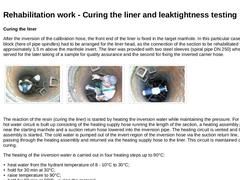
|
Curing the liner After the inversion of the calibration hose, the front end of the liner is fixed in the target manhole. In this particular case, a bearing block (here of pipe spindles) had to be arranged for the liner head, as the connection of the section to be rehabilitated was approximately 1.5 m above the manhole invert. The liner was provided with two steel sleeves (spiral pipe DN 250) whereby the first served for the later taking of a sample … |
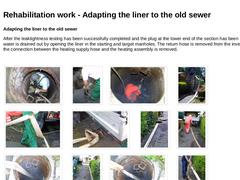
|
Adapting the liner to the old sewer After the leaktightness testing has been successfully completed and the plug at the lower end of the section has been removed, the water is drained out by opening the liner in the starting and target manholes. The return hose is removed from the inversion pipe and the connection between the heating supply hose and the heating assembly is removed. | | | | | | | | (Image: Pulling out the sealing element) | (Image: Pulling … |
|
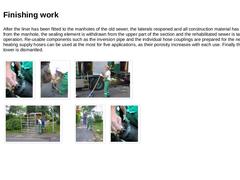
|
After the liner has been fitted to the manholes of the old sewer, the laterals reopened and all construction material has been removed from the manhole, the sealing element is withdrawn from the upper part of the section and the rehabilitated sewer is taken into operation. Re-usable components such as the inversion pipe and the individual hose couplings are prepared for the next use. The heating supply hoses can be used at the most for five applications, … |
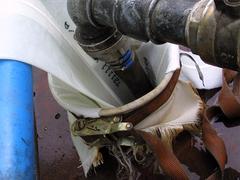
|
Lining of a DN 250 vitrified clay sewer with a flexible tube (KM in-liner) impregnated with a reactive resin, forming a pipe after curing of the resin (CIPP). |
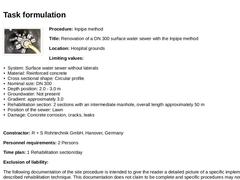
|
(Image: 18712 - Titelbild Dokumentation) Procedure: Inpipe method Title: Renovation of a DN 300 surface water sewer with the Inpipe method Location: Hospital grounds Limiting values: - System: Surface water sewer without laterals
- Material: Reinforced concrete
- Cross sectional shape: Circular profile
- Nominal size: DN 300
- Depth position: 2.0 - 3.0 m
- Groundwater: Not present
- Gradient: approximately 3.0
- Rehabilitation section: 2 sections with an intermediate …
|
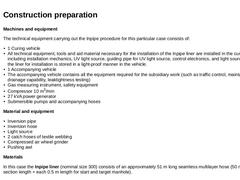
|
Machines and equipment The technical equipment carrying out the Inpipe procedure for this particular case consists of: - 1 Curing vehicle
- All technical equipment, tools and aid material necessary for the installation of the Inpipe liner are installed in the curing vehicle, including installation mechanics, UV light source, guiding pipe for UV light source, control electronics, and light source winch. Also the liner for installation is stored in a light-…
|
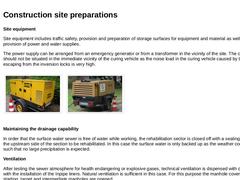
|
Site equipment Site equipment includes traffic safety, provision and preparation of storage surfaces for equipment and material as well as the provision of power and water supplies. The power supply can be arranged from an emergency generator or from a transformer in the vicinity of the site. The compressor should not be situated in the immediate vicinity of the curing vehicle as the noise load in the curing vehicle caused by the air escaping from … |
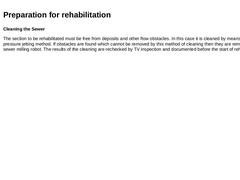
|
Cleaning the Sewer The section to be rehabilitated must be free from deposits and other flow obstacles. In this case it is cleaned by means of the high-pressure jetting method. If obstacles are found which cannot be removed by this method of cleaning then they are removed using a sewer milling robot. The results of the cleaning are rechecked by TV inspection and documented before the start of rehabilitation. |
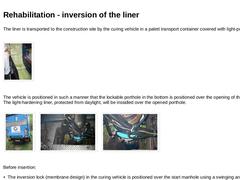
|
Renovation of a surface water sewer DN 300 by the Inpipe process - Rehabilitation - Inversion of the liner |
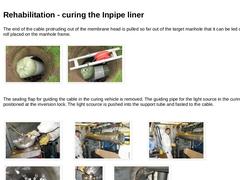
|
The end of the cable protruding out of the membrane head is pulled so far out of the target manhole that it can be led over a turning roll placed on the manhole frame. | (Image: Arrival of the liner in the target manhole) | (Image: Pulling the cable from the membrane head of the liner up to the turning roll) |
The sealing flap for guiding the cable in the curing vehicle is removed. The guiding pipe for the light source in the curing vehicle is positioned … |
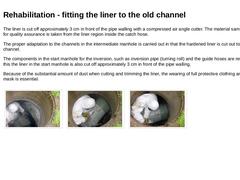
|
The liner is cut off approximately 3 cm in front of the pipe walling with a compressed air angle cutter. The material sample required for quality assurance is taken from the liner region inside the catch hose. The proper adaptation to the channels in the intermediate manhole is carried out in that the hardened liner is cut out to form a channel. The components in the start manhole for the inversion, such as inversion pipe (turning roll) and the guide … |
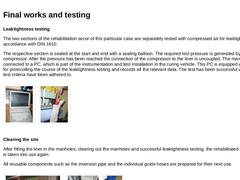
|
Leaktightness testing The two sections of the rehabilitation secor of this particular case are separately tested with compressed air for leaktightness in accordance with DIN 1610. The respective section is sealed at the start and end with a sealing balloon. The required test pressure is generated by a compressor. After the pressure has been reached the connection of the compressor to the liner is uncoupled. The manometer is connected to a PC, which … |
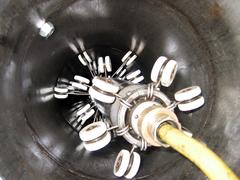
|
Lining of a DN 300 surface water sewer with a flexible tube (in-pipe method) impregnated with a reactive resin, forming a pipe after curing of the resin (CIPP). |
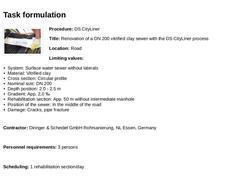
|
(Image: 33651 - Titelbild Dokumentation) Procedure: DS CityLiner Title: Renovation of a DN 200 vitrified clay sewer with the DS CityLiner process Location: Road Limiting values: - System: Surface water sewer without laterals
- Material: Vitrified clay
- Cross section: Circular profile
- Nominal size: DN 200
- Depth position: 2.0 - 2.5 m
- Gradient: App. 2,0 ‰
- Rehabilitation section: App. 50 m without intermediate manhole
- Position of the sewer: In the middle of the …
|
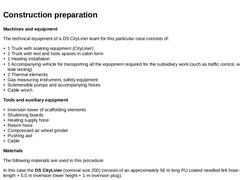
|
Machines and equipment The technical equipment of a DS CityLiner team for this particular case consists of: - 1 Truck with soaking equipment (CityLiner)
- 1 Truck with rest and tools spaces in cabin form
- 1 Heating installation
- 1 Accompanying vehicle for transporting all the equipment required for the subsidiary work (such as traffic control, water retention, leak testing)
- 2 Thermal elements
- Gas measuring instrument, safety equipment
- Submersible pumps and …
|
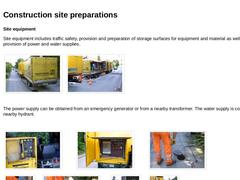
|
Site equipment Site equipment includes traffic safety, provision and preparation of storage surfaces for equipment and material as well as the provision of power and water supplies. | (Image: Traffic safety at the erection surfaces) | (Image: Traffic safety at the erection surfaces) |
The power supply can be obtained from an emergency generator or from a nearby transformer. The water supply is connected to a nearby hydrant. |
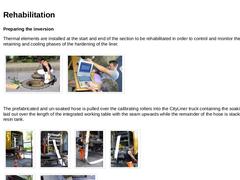
|
Preparing the inversion Thermal elements are installed at the start and end of the section to be rehabilitated in order to control and monitor the heating, retaining and cooling phases of the hardening of the liner. | (Image: Installation of the thermal elements) | (Image: Programming the thermometers) |
The prefabricated and un-soaked hose is pulled over the calibrating rollers into the CityLiner truck containing the soaking plant. It is laid out over … |
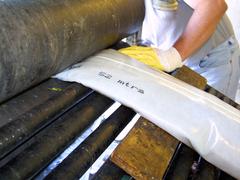
|
Soaking and inversion of the hose A filling opening of 5 cm long is cut in the hose approximately 1 m from the calibrating rolls. The filling hose for soaking with the epoxy resin is pushed about half a metre into this opening in the hose. The previously determined resin quantity for the inversion length is filled into the hose and slowly distributed backwards with the hands. Care must be taken that soaking is complete. | (Image: Soaking the hose in … |
|
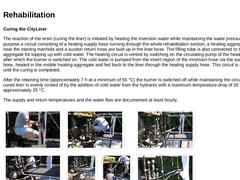
|
Curing the CityLiner The reaction of the resin (curing the liner) is initiated by heating the inversion water while maintaining the water pressure. For this purpose a circuit consisting of a heating supply hose running through the whole rehabilitation section, a heating aggregate positioned near the starting manhole and a suction return hose are built up in the liner hose. The filling tube is also connected to the heating aggregate for topping up … |
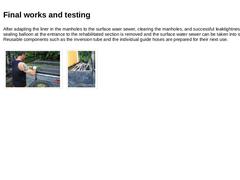
|
After adapting the liner in the manholes to the surface waer sewer, clearing the manholes, and successful leaktightness testing, the sealing balloon at the entrance to the rehabilitated section is removed and the surface water sewer can be taken into service again. Reusable components such as the inversion tube and the individual guide hoses are prepared for their next use. | (Image: Disassembling the inversion tower) | (Image: Disassembling the inversion … |
|

|
Lining of a vitrified clay sewer nominal width DN 200 with a flexible tube (DS CityLiner) impregnated with a reactive resin, forming a pipe after curing of the resin (CIPP). |
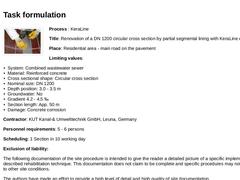
|
(Image: 18460 - Titelbild Dokumentation) Process : KeraLine Title: Renovation of a DN 1200 circular cross section by partial segmental lining with KeraLine elements Place: Residential area - main road on the pavement Limiting values: - System: Combined wastewater sewer
- Material: Reinforced concrete
- Cross sectional shape: Circular cross section
- Nominal size: DN 1200
- Depth position: 3.0 - 3.5 m
- Groundwater: No
- Gradient 4.2 - 4.5 ‰
- Section length: App. 50 …
|
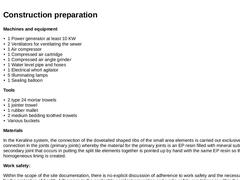
|
Machines and equipment - 1 Power generator at least 10 KW
- 2 Ventilators for ventilating the sewer
- 1 Air compressor
- 1 Compressed air cartridge
- 1 Compressed air angle grinder
- 1 Water level pipe and hoses
- 1 Electrical whorl agitator
- 5 Illuminating lamps
- 1 Sealing balloon
Tools - 2 type 24 mortar trowels
- 1 jointer trowel
- 1 rubber mallet
- 2 medium bedding toothed trowels
- Various buckets
Materials In the Keraline system, the connection of the dovetailed shaped … |
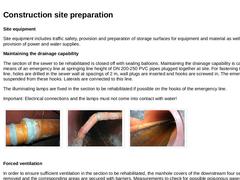
|
Site equipment Site equipment includes traffic safety, provision and preparation of storage surfaces for equipment and material as well as the provision of power and water supplies. Maintaining the drainage capability The section of the sewer to be rehabilitated is closed off with sealing balloons. Maintaining the drainage capability is carried out by means of an emergency line at springing line height of DN 200-250 PVC pipes plugged together at site. … |
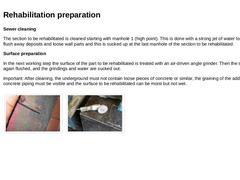
|
Sewer cleaning The section to be rehabilitated is cleaned starting with manhole 1 (high point). This is done with a strong jet of water to remove and flush away deposits and loose wall parts and this is sucked up at the last manhole of the section to be rehabilitated. Surface preparation In the next working step the surface of the part to be rehabilitated is treated with an air-driven angle grinder. Then the surface is once again flushed, and the grindings … |